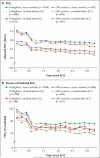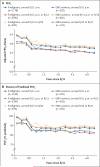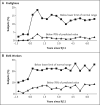Lung function in rescue workers at the World Trade Center after 7 years
- PMID: 20375403
- PMCID: PMC4940972
- DOI: 10.1056/NEJMoa0910087
Lung function in rescue workers at the World Trade Center after 7 years
Abstract
Background: The terrorist attacks on the World Trade Center on September 11, 2001, exposed thousands of Fire Department of New York City (FDNY) rescue workers to dust, leading to substantial declines in lung function in the first year. We sought to determine the longer-term effects of exposure.
Methods: Using linear mixed models, we analyzed the forced expiratory volume in 1 second (FEV(1)) of both active and retired FDNY rescue workers on the basis of spirometry routinely performed at intervals of 12 to 18 months from March 12, 2000, to September 11, 2008.
Results: Of the 13,954 FDNY workers who were present at the World Trade Center between September 11, 2001, and September 24, 2001, a total of 12,781 (91.6%) participated in this study, contributing 61,746 quality-screened spirometric measurements. The median follow-up was 6.1 years for firefighters and 6.4 years for emergency-medical-services (EMS) workers. In the first year, the mean FEV(1) decreased significantly for all workers, more for firefighters who had never smoked (a reduction of 439 ml; 95% confidence interval [CI], 408 to 471) than for EMS workers who had never smoked (a reduction of 267 ml; 95% CI, 263 to 271) (P<0.001 for both comparisons). There was little or no recovery in FEV(1) during the subsequent 6 years, with a mean annualized reduction in FEV(1) of 25 ml per year for firefighters and 40 ml per year for EMS workers. The proportion of workers who had never smoked and who had an FEV(1) below the lower limit of the normal range increased during the first year, from 3% to 18% for firefighters and from 12% to 22% for EMS workers, stabilizing at about 13% for firefighters and 22% for EMS workers during the subsequent 6 years.
Conclusions: Exposure to World Trade Center dust led to large declines in FEV(1) for FDNY rescue workers during the first year. Overall, these declines were persistent, without recovery over the next 6 years, leaving a substantial proportion of workers with abnormal lung function.
2010 Massachusetts Medical Society
Figures




Comment in
-
Recommended reading from the University of Michigan Pulmonary and Critical Care Fellows: Marc Peters-Golden, M.D., program director.Am J Respir Crit Care Med. 2011 Jan 1;183(1):129-30. doi: 10.1164/rccm.201008-1324RR. Am J Respir Crit Care Med. 2011. PMID: 21193786 No abstract available.
References
-
- Gibbs L, Frieden TR, World Trade Center Medical Working Group of NYC [March 12, 2010];2008 Annual report on 9/11 health. 2008 Sep; (at http://www.nyc.gov/html/om/pdf/2008/2008_mwg_annual_report.pdf.)
-
- Skloot GS, Schechter CB, Herbert R, et al. Longitudinal assessment of spirometry in the World Trade Center Medical Monitoring Program. Chest. 2009;135:492–8. [Erratum, Chest 2009;135:1114.] - PubMed
-
- Miller MR, Hankinson J, Brusasco V, et al. Standardisation of spirometry. Eur Respir J. 2005;26:319–38. - PubMed
Publication types
MeSH terms
Substances
Grants and funding
LinkOut - more resources
Full Text Sources
Medical
